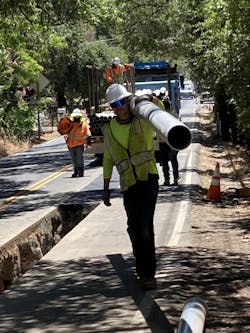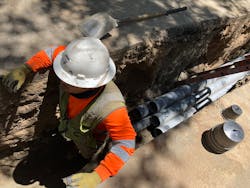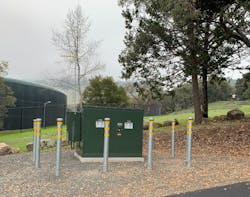An Inside Look at a PG&E Undergrounding Project
During severe weather, Pacific Gas and Electric Co. and other utilities in the West shut off power to prevent vegetation and other debris from encountering energized power lines and starting a wildfire. Pacific Gas and Electric Co. (PG&E) works year-round to harden its system and reduce the number and impact of these public safety power shutoff (PSPS) events. Its system hardening efforts have included installing stronger, more resilient equipment, such as power poles and conductor, as well as removing overhead powerlines and burying them underground.
In September 2021, PG&E successfully completed undergrounding nearly 4 miles (6.4 km) of overhead power lines in Santa Rosa, California, U.S. This project not only did it helped with system hardening and wildfire mitigation, but it also improved reliability for approximately 11,000 customers. Residents and businesses in portions of the Rincon Valley and Oakmont neighborhoods in Santa Rosa had been impacted by several PSPS events over the last couple of years. Now that the lines serving those customers are underground, the risk of a fire from vegetation contact with overhead conductors has been mitigated and the customers have not been impacted recently by PSPS events.
“By placing some of our power lines in the most fire-prone areas underground, we greatly reduce the need to impact our customers and turn off their power for safety during high winds and extremely dry weather events,” said Brad Koelling, manager of grid design at PG&E. “Specifically, this project helps eliminate the need for PG&E to turn the power off for thousands of residents in Rincon Valley and the Oakmont community, as well as businesses and schools that are not in a High Fire Threat District.”
Reducing Wildfire Risk
Of PG&E’s 25,000 miles (40,234 km) of overhead distribution lines, 30% traverse the highest fire-threat areas (Tier 2, Tier 3 and Zone 1) in California. These areas are referred to as High Fire Threat Districts (HFTDs). Since the devastating October 2017 Northern California wildfires and 2018 Camp Fire, undergrounding has become a more viable option as part of the utility’s efforts in reducing wildfire risk.
Today, PG&E is in the process of burying overhead electric distribution lines in the town of Paradise and surrounding areas that were destroyed in the 2018 Camp Fire. The heat from the 2017 Tubbs Fire damaged the utility’s underground electrical equipment, such as cables and transformers, in Santa Rosa’s Coffey Park neighborhood. While PG&E replaced 22 miles (35 km) of that electric cable, crews
built 10 miles (16 km) of a new gas main line in a joint trench that spanned 17 miles (27 km). Multiple undergrounding demonstration projects, aimed at converting overhead powerlines to underground, were initiated in PG&E HFTDs, such as in Alameda, Contra Costa, Nevada and Sonoma counties. One of the objectives of the plan was to better understand the construction and cost requirements associated with undergrounding.
Overhead To Underground
The Santa Rosa area undergrounding project began in April 2021. With the state’s increased wildfire risk and growing need for PG&E to initiate PSPS events in the neighborhoods of Rincon Valley and Oakmont, “time was of the essence,” said Josh Eagar, project manager for this undergrounding project.
Veteran Power Infrastructure (VPI), a certified Disabled Veteran Business Enterprise contractor, performed most of the civil work. The state’s call-before-digging system was notified and one-call system site locators marked the approximate location of buried utilities with paint and flags along the route of planned excavation.
The route was open-cut along streets and sidewalks, running parallel to the existing overhead power line. Trenches, excavated by PG&E’s general construction crews, ranged in depth from 36 inches to 50 inches (914 mm to 1270 mm) and with widths from 18 inches to 24 inches (457 mm to 610 mm).
The overhead distribution facilities were removed and four circuits, 12 kV each, were buried in 2-inch, 4,-inch and 6-inch (51-mm, 102-mm and 152-mm) PVC Schedule 40 conduit. Some of the pole facilities would remain in place to carry telecommunications equipment and service lines that feed power directly to homes and businesses. Summit Construction Solutions Inc. pulled the cable through the conduit.
“Like many construction projects, there were many challenges along the way, including a fast-approaching timeline, acquiring new easements, permits and rights-of-way, and construction difficulties brought on by the limited space of the narrow roadway,” said Jesse Lorz, an electric distribution engineer with PG&E. “These were compounded by other utilities and substructures within the project boundaries.”
“The project also required significant planning and construction coordination with a large volume of stakeholders,” noted Project Manager Eager. “Supplementing our internal crews with contractor support was the only way we could complete the work in time before wildfire season.”
“Our design engineers responded in a timely manner to questions and concerns identified in the field and helped provide direction to crews all while keeping our timeline. A special thanks goes out to our associated partners in performing the work with a fiduciary mindset on behalf of PG&E and the customers it serves,” Eagar added.
Undergrounding also included back-filling and street and sidewalk restoration. Crews were diligent about repairing concrete and asphalt in compliance with city street and sidewalk geometric design standards for pavement cut
and repair standards. In a few cases, landscaping was required.
More Undergrounding Ahead
In July 2021, PG&E announced a multiyear commitment to underground 10,000 miles (16,093 km) of distribution lines in or near HFTDs across the utility’s more than 70,000 sq mile (181,299 sq km) service area in Northern and Central California. This commitment represents the largest effort in the
U.S. to underground power lines as a wildfire risk reduction measure. “Extraordinary times call for extraordinary solutions,” said PG&E’s CEO Patti Poppe. The unprecedented infrastructure safety initiative will further harden PG&E’s system, help to prevent wildfires and lower the need for shutting off power.
Acknowledgment
The author would like to thank these experts at PG&E for contributing to this article: Josh Eagar, a project manager on the T&D project management
team; Jesse Lorz, an electric distribution engineer on the grid design team;
and Brad Koelling, manager of grid design.
Deanna Contreras is a Pacific Gas and Electric Co. (PG&E) media representative and spokesperson for the San Francisco Bay Area and
California’s North Coast. In addition to covering this story for the utility, she writes other internal and external articles about PG&E’s goals for clean energy and grid resiliency. Contreras lives in Santa Rosa, California.
For More Information
PG&E’s Commitment to Undergrounding
On July 21, 2021, Pacific Gas and Electric Co. (PG&E) announced a new multiyear
infrastructure safety initiative to underground approximately 10,000 miles (16,093 km) of power lines in and near high fire-threat areas. This initiative represents the bold, innovative action needed to meet California’s climate challenges and is the largest effort in the U.S. to underground power lines as a wildfire risk reduction measure.
More than one-third of the electric lines that serve PG&E customers are in high wildfire risk areas. California, Oregon and Washington, along with several other western states, continue to experience an increase in wildfire risk and a longer wildfire season. The
increased number of dead trees, drought, hotter temperatures and higher winds because of climate challenges have significantly increased the risk of catastrophic wildfires.
How Will It Work?
PG&E is prioritizing undergrounding in areas where it can have the greatest impact on reducing wildfire risk and public safety power shutoff (PSPS) outages. In addition, the utility is focusing on protecting critical facilities, like hospitals, and looking at a variety of factors, including topography terrain (including accessibility for ingress and egress of areas), constructability, vegetation, existing infrastructure (such as the number of services and transformers), reliability, the potential for trees falling into lines and climate change challenges among others.
When possible, PG&E will prioritize its efforts in areas that address multiple needs and deliver the highest level of safety for customers. Prior to its 10,000-mile undergrounding announcement, the utility had multiple undergrounding projects underway, like the Santa Rosa project. It plans to continue those projects under its current criteria.
To meet its 10,000-mile goal, PG&E plans to significantly increase its underground miles annually. The utility has targeted about 3,600 miles from 2022 to 2026, including: 175 miles in 2022; 400 miles in 2023; 800 miles in 2024; 1,000 miles in 2025; and 1,200 miles in 2026. To support the accelerated rate of undergrounding, the utility will use an engineering, procurement and construction strategy to aid in resourcing and work execution. In addition, it will coordinate with the International Brotherhood of Electrical Workers (IBEW) and the Engineers and Scientists of California (ESC) so resources are available to execute the work.
Building and expanding the electric system underground will not only help PG&E to reduce wildfires caused by equipment, but it also will help to protect trees, improve system reliability and, in some cases, beautify hometowns.
By The Numbers
- 10,000 = Miles PG&E plans to underground in and near high wildfire risk areas
- 1/3 = Electric lines that serve PG&E customers in high wildfire risk areas
- 2662 = Total miles of underground distribution lines in high fire-threat areas
27,000 = Number of electric line miles PG&E currently has underground - Over 20% = number of PG&E’s distribution lines that are underground
1 Million = Trees PG&E prunes or cuts down annually to maintain clearance from power lines - 100,000 = Approximate miles of overhead power lines PG&E inspects at least once
a year
About the Author
Deanna Contreras
Deanna Contreras ([email protected]) is a Pacific Gas and Electric Co. (PG&E) media representative and spokesperson for the San Francisco Bay Area and California’s North Coast. In addition to covering this story for the utility, she writes other internal and external articles about PG&E's goals for clean energy and grid resiliency. Contreras lives in Santa Rosa, California.



